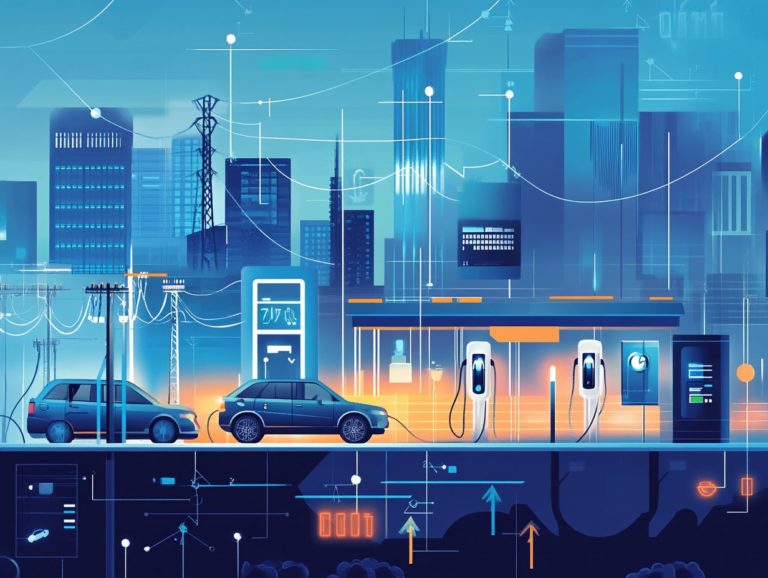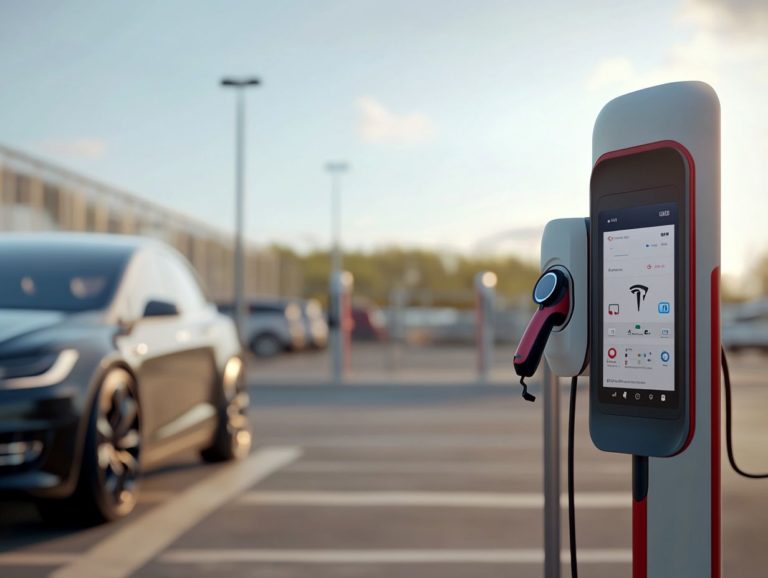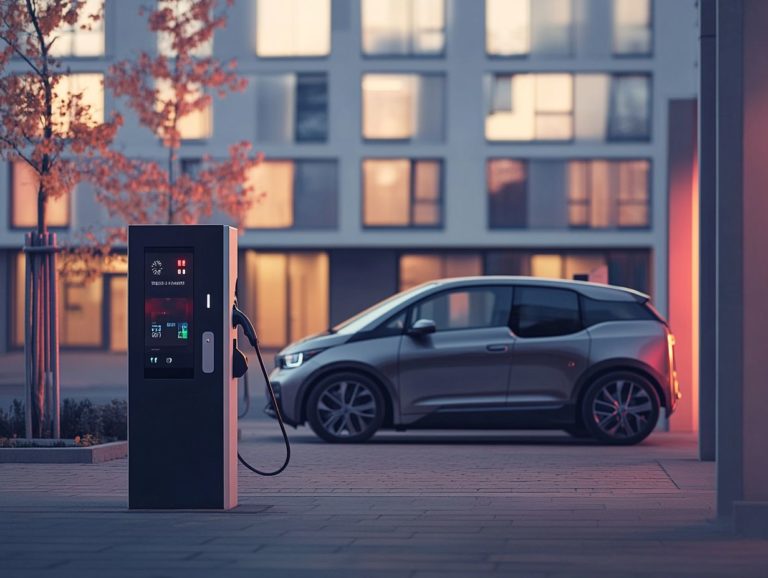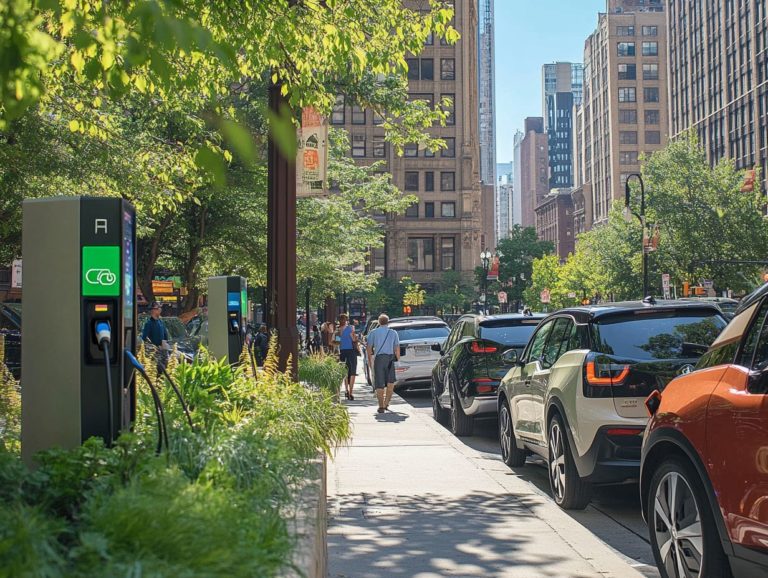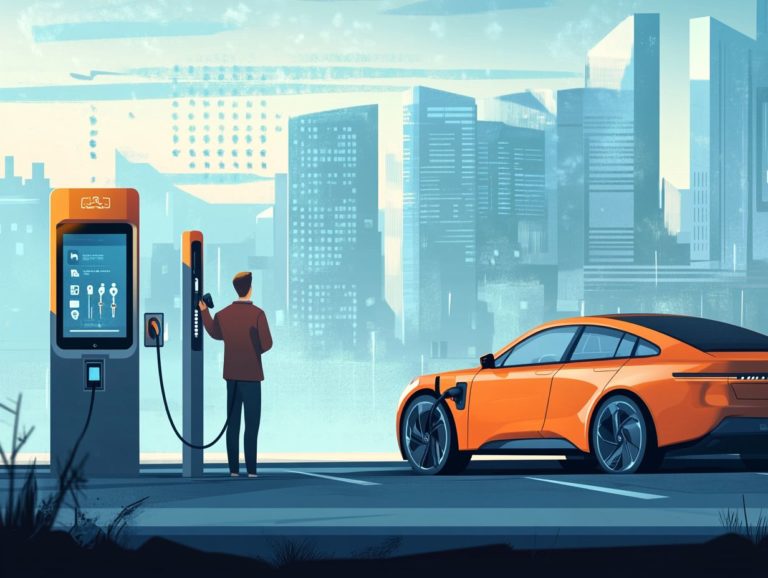10 ways to make ev charging more convenient
As electric vehicles (EVs) gain popularity, finding accessible and efficient charging solutions becomes critical.
This article explores ten innovative strategies to greatly improve EV charging convenience for everyone.
Whether you re an EV owner or curious about sustainable transportation, this guide will show you how to create a more user-friendly charging infrastructure.
Contents
- Quick Tips for Easy EV Charging!
- 1. Install Charging Stations at Convenient Locations
- 2. Offer Incentives for EV Charging
- 3. Utilize Mobile Apps for Charging
- 4. Implement Fast Charging Technology
- 5. Create a Network of Charging Stations
- 6. Integrate Charging Stations with Parking Spaces
- 7. Use Renewable Energy Sources for Charging
- 8. Provide Charging Options at Workplaces
- 9. Offer Home Charging Solutions
- 10. Educate the Public on EV Charging
- How Can EV Charging Be Made More Accessible for Everyone?
- What Are the Challenges of EV Charging in Rural Areas?
- How Can Governments and Businesses Work Together to Improve EV Charging Infrastructure?
- What Are the Advancements in EV Charging Technology?
- How Can EV Charging Be Incorporated into Urban Planning?
- What Are the Benefits of Widespread Adoption of Electric Vehicles (EVs) and Convenient Charging Options?
Quick Tips for Easy EV Charging!
Install charging stations at convenient locations to make it easier for EV owners to recharge.
Offer incentives for EV charging to encourage more people to switch to electric vehicles.
Utilize mobile apps for charging to provide a seamless experience for EV owners.
1. Install Charging Stations at Convenient Locations
Installing EV charging stations at convenient locations is essential for enhancing accessibility!
This ensures that battery-powered cars can easily find charging solutions while on the go.
When strategically placed, these charging stations optimize access for users, allowing you to recharge your vehicle in bustling urban areas or shopping centers.
This promotes electric vehicle adoption and supports energy independence.
Consider locations like workplace parking lots, residential complexes, and popular tourist attractions.
These spots can serve as key charging hubs for you and other EV owners.
By providing easy access to charging options, these installations play a vital role in alleviating range anxiety a genuine concern for potential EV owners.
Statistics reveal that cities like San Diego and Amsterdam have seen increased EV adoption rates due to public charging infrastructure being a cornerstone of their strategies.
As regions implement these solutions, they set a precedent for others and reinforce the idea that convenient charging encourages cleaner transportation choices, paving the way for a more sustainable future.
2. Offer Incentives for EV Charging
Offering incentives for EV charging can significantly boost user participation!
This encourages you to adopt electric vehicles, cultivating a culture of charging etiquette among those using public stations.
Incentives can take many forms, such as enticing discounts for first-time users or reward programs that let you accumulate benefits over time.
Such offerings not only make the shift to electric vehicles more appealing but also help providers build a loyal customer base.
When communities rally around these initiatives, they contribute to sustainable practices, promoting responsible charging habits.
Ultimately, both you and the providers benefit from an ecosystem that supports efficient driving and a shared commitment to a greener future.
3. Utilize Mobile Apps for Charging
Utilizing mobile apps for EV charging can elevate your experience!
These apps make it effortless for you to locate stations, monitor your charging progress, and tailor options to suit your needs.
They provide real-time updates on charging station availability, enabling you to plan routes confidently and avoid the frustration of arriving at a full station.
With integrated payment options, you can complete transactions seamlessly, eliminating the hassle of juggling multiple cards.
Navigation assistance guides you to the nearest charging stations, taking into account your current battery level.
The integration of smart charging technologies enhances energy management, enabling cost savings while minimizing environmental impact.
This offers a level of convenience that transforms the EV charging experience into something user-friendly and efficient, especially when you know how to maximize your EV charging experience.
In conclusion, implementing these strategies will foster a more accessible and efficient EV charging infrastructure, benefiting both current and future first-time EV owners.
4. Implement Fast Charging Technology
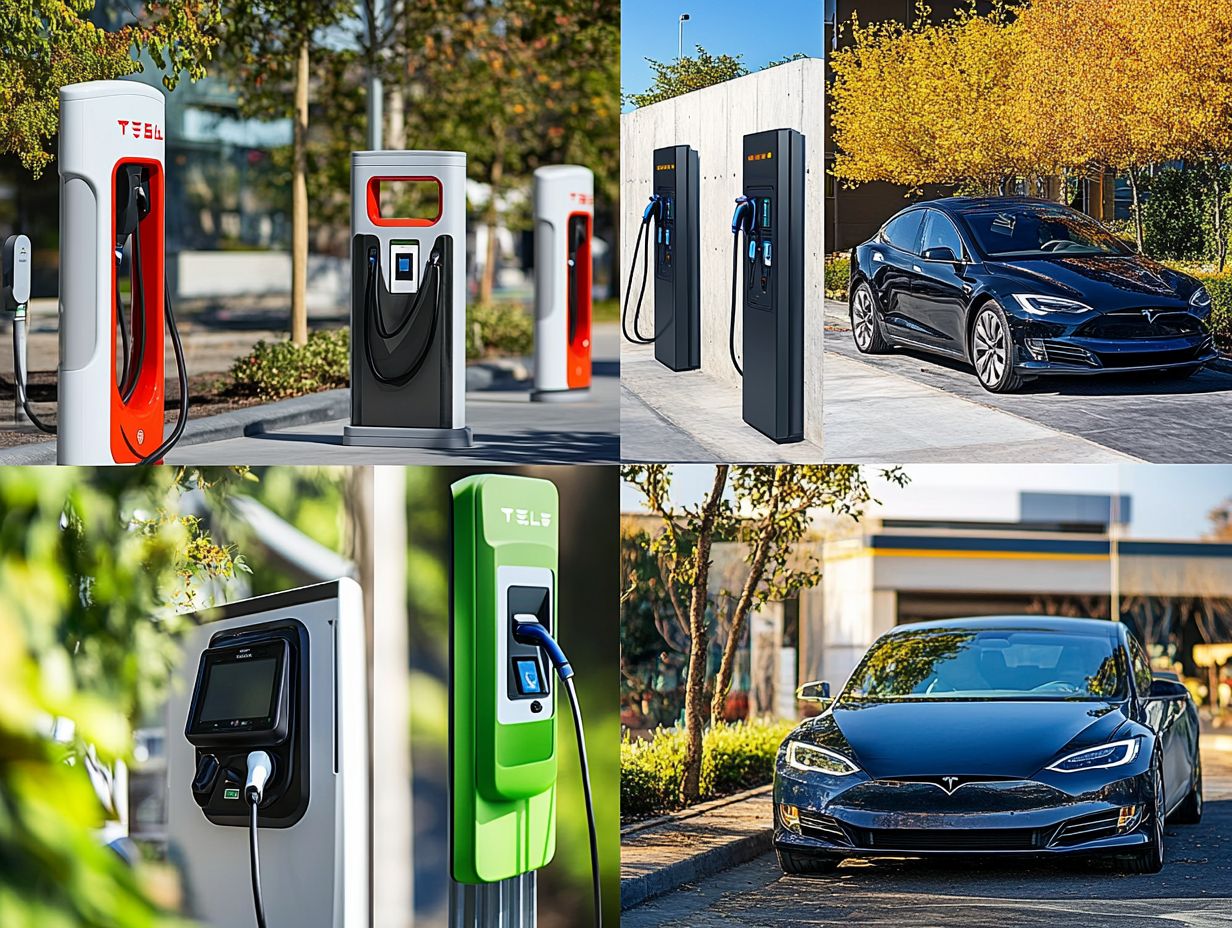
Implementing fast charging technology is crucial for enhancing efficiency. It dramatically cuts down charging time for electric vehicle drivers seeking quick solutions.
This innovation includes Level 2 chargers, which reduce charging time significantly. They are great for home or workplace installations.
DC fast charging stations take it a step further. They let you add hundreds of miles of range in just minutes!
As more drivers embrace electric vehicles, the importance of fast charging technology in creating a seamless experience becomes clear.
5. Create a Network of Charging Stations
A strong network of charging stations is vital for a robust infrastructure. It meets the growing demand for electric vehicles and increases accessibility.
This network boosts EV adoption by easing range anxiety. You ll feel confident embarking on longer journeys without worry.
Improved user experience is another advantage, as a well-designed charging system minimizes wait times and offers seamless payment options.
Incorporating renewable energy sources like solar and wind helps create a cleaner environment and reduces operational costs.
Look to countries like Norway and Germany, which have successfully implemented extensive charging networks, paving the way for sustainable transportation solutions.
6. Integrate Charging Stations with Parking Spaces
Integrating charging stations with parking spaces enhances convenience. Imagine charging your car while you park!
This combination addresses the growing demand for electric vehicles and contributes to a sustainable urban environment.
When considering such integrations, it s essential to evaluate factors like space allocation and user accessibility.
Enforcing proper charging etiquette is crucial for keeping these facilities operational. By adopting best practices, you can improve energy management and foster a community that values eco-friendly transportation.
7. Use Renewable Energy Sources for Charging
Using renewable energy for EV charging is essential for reducing your carbon footprint. This makes your charging more sustainable and environmentally friendly.
Consider solar panels for your charging stations! They capture sunlight and convert it to electricity.
Wind turbines can also generate energy, even on cloudy days.
Incorporating battery storage systems allows excess energy to be saved for later use, maximizing the benefits of renewable energy.
Recent studies indicate that utilizing renewable resources could cut greenhouse gas emissions from EV charging by up to 70%. Join the movement towards greener transportation today!
8. Provide Charging Options at Workplaces
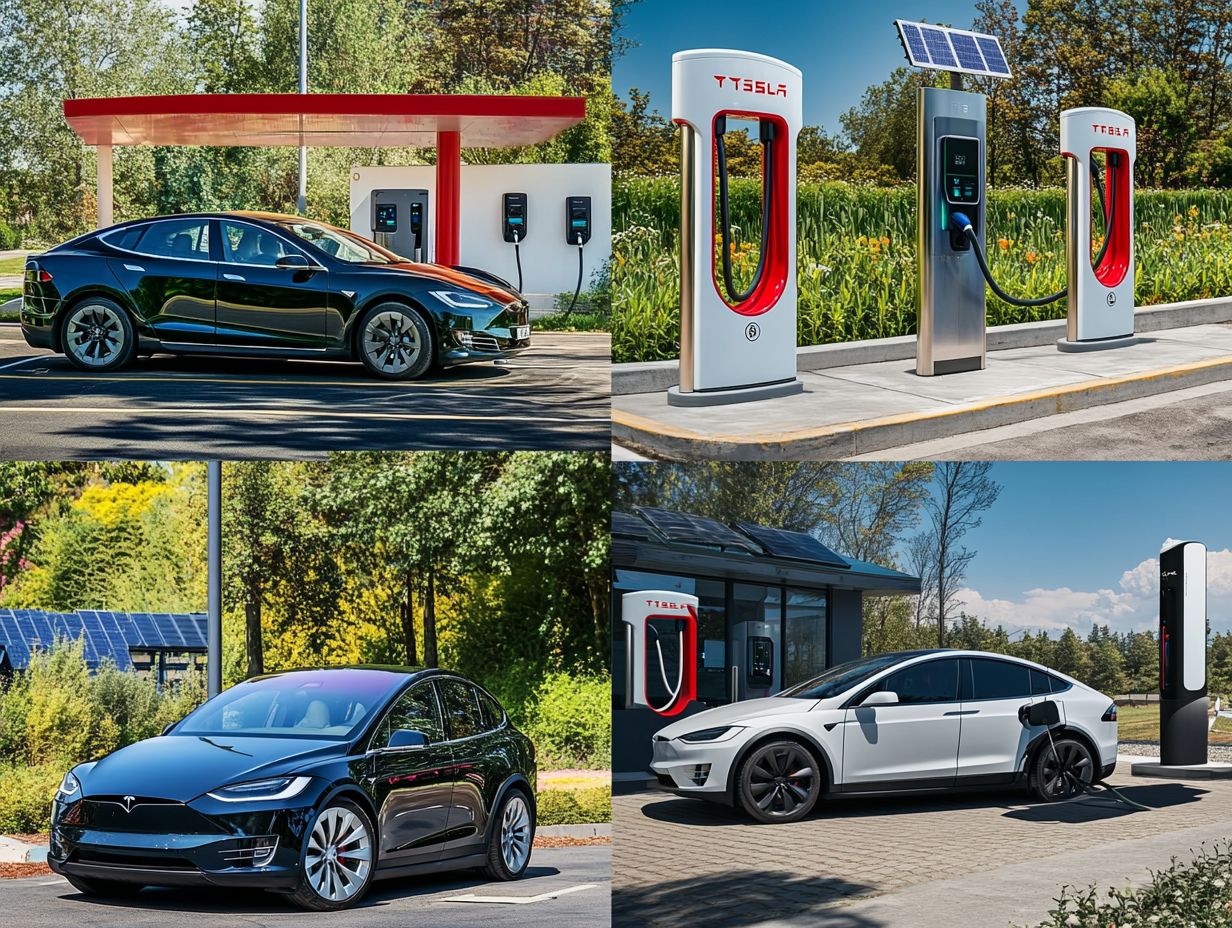
Providing charging options at your workplace is an effective way to promote EV usage among employees. It simplifies their transition to electric vehicles and enhances their commitment to energy independence.
By integrating workplace charging stations, you can create a supportive environment for electric vehicle adoption. This initiative alleviates concerns about charging infrastructure and showcases your organization s commitment to sustainability.
Engaging with charging network providers can streamline installations. This ensures employees have convenient access to charge their vehicles during work hours.
Companies like Google and Tesla have successfully implemented such programs, witnessing a significant increase in employee EV adoption rates.
This collaborative approach benefits your workforce and strengthens your company s reputation as a leader in environmental responsibility.
9. Offer Home Charging Solutions
Home charging solutions, like fast chargers, greatly enhance the experience for electric vehicle owners. Imagine charging your car right at home!
With this setup, you save time and money. Charging at home is often cheaper than using public stations.
When considering a home charging option, it s essential to choose the right equipment. Fast chargers are recommended for their quicker charging times and efficiency.
Explore local incentives, including rebates or tax credits, to help offset installation costs. Hiring a certified electrician for the installation ensures safety and compliance with local codes.
This makes your transition to home charging smooth and hassle-free.
10. Educate the Public on EV Charging
Educating the public on EV charging is essential for cultivating understanding and courtesy. It ensures that electric vehicle owners are well-informed about charging etiquette and best practices for using public charging stations.
Participating in workshops offers valuable hands-on learning experiences. You’ll become familiar with charging technology and its operational intricacies.
If you prefer flexibility, online resources like webinars and interactive websites are great for self-paced learning.
Engaging in community programs connects you with local neighborhoods. This fosters discussions about sustainable transportation and advocates for the benefits of electric vehicles.
As you learn more, you’ll improve your charging skills and help others do the same! This growing knowledge plays a crucial role in increasing EV adoption by demystifying the technology.
As awareness spreads, you and others are more likely to embrace electric vehicles. Join the movement towards sustainable transportation today!
How Can EV Charging Be Made More Accessible for Everyone?
Making EV charging accessible to everyone is a complex challenge. It calls for collaboration among policymakers, businesses, and communities to craft innovative charging solutions and enhance public charging infrastructure.
To tackle this issue effectively, consider strategies such as expanding charging networks in underserved areas. This ensures electric vehicles aren t confined to urban spaces.
Educational programs on charging etiquette foster understanding among users. This encourages everyone to share resources fairly and efficiently.
Implementing incentives for low-income households can promote easier adoption of electric vehicles. This makes them more feasible for a broader demographic.
By prioritizing inclusivity in these initiatives, you can help cultivate a sustainable future where everyone benefits from electric mobility.
What Are the Challenges of EV Charging in Rural Areas?

The challenges of EV charging in rural areas often arise from limited charging infrastructure. This creates significant hurdles for adopting electric vehicles in these communities.
Without accessible charging stations, moving away from traditional fuel sources can be very tough. This raises concerns about range anxiety and the practicality of owning an EV.
This lack of investment in infrastructure can deter potential buyers and dampen local enthusiasm for electric mobility. Public awareness is another significant obstacle; many individuals in these regions may not fully understand the benefits of EVs and the charging options available.
Exciting solutions are emerging! Implementing mobile charging units during peak travel times or partnering with local businesses for charging facilities can significantly enhance access.
How Can Governments and Businesses Work Together to Improve EV Charging Infrastructure?
Collaboration between governments and businesses is vital for enhancing EV charging infrastructure. These partnerships can drive innovation and investment in effective charging solutions.
Such alliances are key to establishing extensive networks of charging stations that meet the rising demand for electric vehicles. Cities and private firms have successfully teamed up to deploy charging stations in urban areas, easing range anxiety for electric vehicle users.
Joint funding initiatives and shared resources enable rapid rollout of advanced technology. This not only enriches your user experience but also encourages more drivers to switch to electric.
The synergy from these collaborations fosters a sustainable environment, ensuring a cleaner, electric-powered future for everyone.
What Are the Advancements in EV Charging Technology?
Recent advancements in EV charging technology have improved efficiency and convenience. Smart charging solutions and enhanced Level 2 chargers are key developments, along with 5 must-have accessories for EV charging.
These innovations create a smoother user experience, with features like wireless charging that eliminates the need for cumbersome connectors. This simplifies the charging process significantly.
Charging that allows your vehicle to return electricity to the grid during peak times enhances energy management effectively. Integration with renewable energy sources like solar and wind is revolutionizing the EV landscape.
As these technologies evolve, the infrastructure will become more robust, encouraging greater adoption and significantly improving the lives of electric vehicle owners.
How Can EV Charging Be Incorporated into Urban Planning?
Incorporating EV charging into urban planning is vital for a sustainable transportation ecosystem. This approach accommodates the increasing number of electric vehicles on the road.
Urban planners must strategically integrate charging stations into new developments and existing neighborhoods. Placing charging points in high-traffic areas like shopping centers and residential complexes enhances accessibility.
Thoughtful placement incentivizes EV adoption and encourages efficient driving habits. As technology evolves, understanding the future trends in EV charging technology will help drivers conveniently charge while going about their daily activities.
Analyzing usage patterns helps develop a network that minimizes wait times. This ultimately contributes to a greener urban environment.
What Are the Benefits of Widespread Adoption of Electric Vehicles (EVs) and Convenient Charging Options?
The widespread adoption of electric vehicles (EVs) and easy charging options brings you numerous benefits. You can expect reduced greenhouse gas emissions, greater energy independence, and cleaner air in cities who wouldn t want that?
This move towards electric mobility is driving exciting growth in clean energy jobs. Global investments could exceed $1 trillion by 2030, creating millions of jobs. Estimates suggest up to 10 million positions in manufacturing, maintenance, and infrastructure development will be available by the end of the decade.
This transition not only saves you money on fuel costs; it also boosts public health. Imagine saving lives! Studies reveal that reducing air pollution could prevent around 100,000 premature deaths each year in the U.S. alone.
Looking forward, improvements in battery technology and solar energy use will enhance these benefits even more. This will lead to increased adoption rates and a brighter, more sustainable future.


